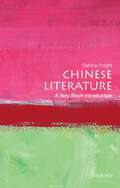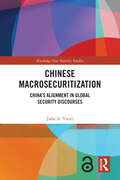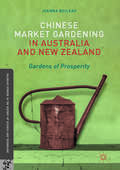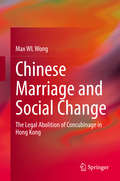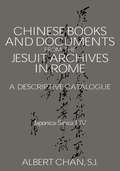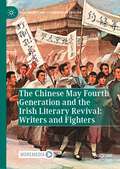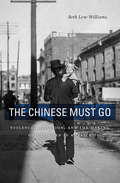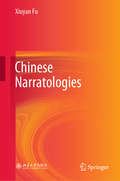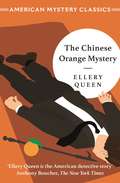- Table View
- List View
Chinese Literature: A Very Short Introduction (Very Short Introductions)
by Sabina KnightPerhaps nowhere else has literature been as conscious a collective endeavor as in China, and China's survival over three thousand years may owe more to its literary traditions than to its political history. This Very Short Introduction tells the story of Chinese literature from antiquity to the present, focusing on the key role literary culture played in supporting social and political concerns. Embracing traditional Chinese understandings of literature as encompassing history and philosophy as well as poetry and poetics, storytelling, drama, and the novel, Sabina Knight discusses the philosophical foundations of literary culture as well as literature's power to address historical trauma and cultivate moral and sensual passions. From ancient historical records through the modernization and globalization of Chinese literature, Knight draws on lively examples to underscore the close relationship between ethics and aesthetics, as well as the diversity of Chinese thought. Knight also illuminates the role of elite patronage; the ways literature has served the interests of specific groups; and questions of canonization, language, nationalism, and cross-cultural understanding. The book includes Chinese characters for names, titles, and key terms.
Chinese Macrosecuritization: China's Alignment in Global Security Discourses (Routledge New Security Studies)
by Juha A. VuoriThis book provides a holistic picture of Chinese global security discourses, with a focus on macrosecuritizations. The work examines how the People’s Republic of China (PRC) has aligned itself within global security discourses. This is approached through the theory of securitization, specifically by using the notion of macrosecuritization as the lens for its analysis. The book offers the first full account of Chinese macrosecuritization discourses and alignments, and it aims to discern what security speech with referent objects such as humanity, civilization, or nature has done in the domestic and international politics of China. Specifically, the work focuses on the discourses of the Cold War, anti-nuclear weapons, climate change, and the Global War on Terror, which have all been postulated in the literature as macrosecuritizations. In addition, it examines discourses with global referent objects that have been put forth by the PRC so that we can see whether its proposals for global security governance take the form of, or are legitimated through, macrosecuritization. The overall argument in the book is that the way contemporary China uses macrosecuritization discourses provides for ontological security as its position in relation to other major powers is undergoing transformation, by allowing it to maintain a consistent narrative of its international self that abides by its own set of moral values and sense of worth. This book will be of interest to students of critical security studies, Chinese politics and International Relations.
Chinese Macrosecuritization: China's Alignment in Global Security Discourses (Routledge New Security Studies)
by Juha A. VuoriThis book provides a holistic picture of Chinese global security discourses, with a focus on macrosecuritizations. The work examines how the People’s Republic of China (PRC) has aligned itself within global security discourses. This is approached through the theory of securitization, specifically by using the notion of macrosecuritization as the lens for its analysis. The book offers the first full account of Chinese macrosecuritization discourses and alignments, and it aims to discern what security speech with referent objects such as humanity, civilization, or nature has done in the domestic and international politics of China. Specifically, the work focuses on the discourses of the Cold War, anti-nuclear weapons, climate change, and the Global War on Terror, which have all been postulated in the literature as macrosecuritizations. In addition, it examines discourses with global referent objects that have been put forth by the PRC so that we can see whether its proposals for global security governance take the form of, or are legitimated through, macrosecuritization. The overall argument in the book is that the way contemporary China uses macrosecuritization discourses provides for ontological security as its position in relation to other major powers is undergoing transformation, by allowing it to maintain a consistent narrative of its international self that abides by its own set of moral values and sense of worth. This book will be of interest to students of critical security studies, Chinese politics and International Relations.
Chinese Maritime Power in the 21st Century: Strategic Planning, Policy and Predictions (Cass Series: Naval Policy and History)
by Hu BoThis book analyses China’s maritime strategy for the 21st century, integrating strategic planning, policy thinking and strategic prediction. This book explains the construction and application of China's military, political, economic and diplomatic means for building maritime power, and predicts the future of China's maritime power by 2049, as well as development trends in global maritime politics. It explores both the strengths and the limitations of President Xi’s ‘Maritime Dream’ and provides a candid assessment of the likely future balance at sea between China and the United States. This volume explains and discusses China’s claims and intentions in the East and South China Seas and makes some recommendations for China's future policy that will lessen the chance of conflict with the United States and its closer neighbors. This book will be of much interest to students of maritime strategy, naval studies, Chinese politics and International Relations in general.
Chinese Maritime Power in the 21st Century: Strategic Planning, Policy and Predictions (Cass Series: Naval Policy and History)
by Hu BoThis book analyses China’s maritime strategy for the 21st century, integrating strategic planning, policy thinking and strategic prediction. This book explains the construction and application of China's military, political, economic and diplomatic means for building maritime power, and predicts the future of China's maritime power by 2049, as well as development trends in global maritime politics. It explores both the strengths and the limitations of President Xi’s ‘Maritime Dream’ and provides a candid assessment of the likely future balance at sea between China and the United States. This volume explains and discusses China’s claims and intentions in the East and South China Seas and makes some recommendations for China's future policy that will lessen the chance of conflict with the United States and its closer neighbors. This book will be of much interest to students of maritime strategy, naval studies, Chinese politics and International Relations in general.
Chinese Market Gardening in Australia and New Zealand: Gardens of Prosperity
by Joanna BoileauThis book offers a fresh perspective on the Chinese diaspora. It is about the mobilisation of knowledge across time and space, exploring the history of Chinese market gardening in Australia and New Zealand. It enlarges our understanding of processes of technological change and human mobility, highlighting the mobility of migrants as an essential element in the mobility and adaptation of technologies. Truly multidisciplinary, Chinese Market Gardening in Australia and New Zealand incorporates elements of economic, agricultural, social, cultural and environmental history, along with archaeology, to document how Chinese market gardeners from subtropical southern China adapted their horticultural techniques and technologies to novel environments and the demands of European consumers. It shows that they made a significant contribution to the economies of Australia and New Zealand, developing flexible strategies to cope with the vagaries of climate and changing business and social environments which were often hostile towards Asian immigrants. Chinese Market Gardening in Australia and New Zealand will appeal to students and scholars in the fields of the Chinese diaspora, in particular the history of the Chinese in Australasia; the history of technology; horticultural and garden history; and environmental history, as well as Asian studies more generally.
Chinese Market Gardening in Australia and New Zealand: Gardens of Prosperity(PDF)
by Joanna BoileauThis book offers a fresh perspective on the Chinese diaspora. It is about the mobilisation of knowledge across time and space, exploring the history of Chinese market gardening in Australia and New Zealand. It enlarges our understanding of processes of technological change and human mobility, highlighting the mobility of migrants as an essential element in the mobility and adaptation of technologies. Truly multidisciplinary, Chinese Market Gardening in Australia and New Zealand incorporates elements of economic, agricultural, social, cultural and environmental history, along with archaeology, to document how Chinese market gardeners from subtropical southern China adapted their horticultural techniques and technologies to novel environments and the demands of European consumers. It shows that they made a significant contribution to the economies of Australia and New Zealand, developing flexible strategies to cope with the vagaries of climate and changing business and social environments which were often hostile towards Asian immigrants. Chinese Market Gardening in Australia and New Zealand will appeal to students and scholars in the fields of the Chinese diaspora, in particular the history of the Chinese in Australasia; the history of technology; horticultural and garden history; and environmental history, as well as Asian studies more generally.
Chinese Marriage and Social Change: The Legal Abolition of Concubinage in Hong Kong
by Max WL WongThis book provides a comparative account of the abolition of concubinage in East Asia, offering a new perspective and revised analysis of the factors leading to – and the debates surrounding – the introduction of a new Marriage Reform Ordinance in Hong Kong in 1971. It uses this law as a platform to examine how the existence of concubinage – long preserved in the name of protecting Chinese traditions and customs — crucially influenced family law reforms, which were in response to a perceived need to create a ‘modern’ marriage system within Hong Kong’s Chinese community after the Second World War. This was, by and large, the result of continued pressure from within Hong Kong and from Britain to bring Hong Kong’s marriage system in line with international marriage treaties. It represented one of the last significant intrusions of colonial law into the private sphere of Hong Kong social life, eliminating Chinese customs which had been previously recognised by the colonial legal system’s family law. This book contextualizes the Hong Kong situation by examining judicial cases interpreting Chinese customs and the Great Qing Code, offering a comprehensive understanding of the Hong Kong situation in relation to the status of concubines in Republican China and other East Asian jurisdictions. It will be of particular interest to teachers and students of law, as well as researchers in gender studies, post-colonialism, sociology and cultural studies.
Chinese Martial Arts Cinema: The Wuxia Tradition (Traditions in World Cinema)
by Stephen TeoThis is the first comprehensive, fully-researched account of the historical and contemporary development of the traditional martial arts genre in the Chinese cinema known as wuxia (literal translation: martial chivalry) - a genre which audiences around the world became familiar with through the phenomenal 'crossover' hit Crouching Tiger, Hidden Dragon (2000). The book unveils rich layers of the wuxia tradition as it developed in the early Shanghai cinema in the late 1920s, and from the 1950s onwards, in the Hong Kong and Taiwan film industries. Key attractions of the book are analyses of:*The history of the tradition as it began in the Shanghai cinema, its rise and popularity as a serialized form in the silent cinema of the late 1920s, and its eventual prohibition by the government in 1931.*The fantastic characteristics of the genre, their relationship with folklore, myth and religion, and their similarities and differences with the kung fu sub-genre of martial arts cinema.*The protagonists and heroes of the genre, in particular the figure of the female knight-errant.*The chief personalities and masterpieces of the genre - directors such as King Hu, Chu Yuan, Zhang Che, Ang Lee, Zhang Yimou, and films such as Come Drink With Me (1966), The One-Armed Swordsman (1967), A Touch of Zen (1970-71), Hero (2002), House of Flying Daggers (2004), and Curse of the Golden Flower (2006).
Chinese Martial Arts Cinema: The Wuxia Tradition (Traditions in World Cinema)
by Stephen TeoIn the fall of 1992, in a small room in Boston, MA, an extraordinary meeting took place. For the first time, the sons and daughters of Holocaust victims met face-to-face with the children of Nazis for a fascinating research project to discuss the intersections of their pasts and the painful legacies that history has imposed on them. Taking that remarkable gathering as its starting point, Justice Matters illustrates how the psychology of hatred and ethnic resentments is passed from generation to generation. Psychologist Mona Weissmark, herself the child of Holocaust survivors, argues that justice is profoundly shaped by emotional responses. In her in-depth study of the legacy encountered by these children, Weissmark found, not surprisingly, that in the face of unjust treatment, the natural response is resentment and deep anger-and, in most cases, an overwhelming need for revenge. Weissmark argues that, while legal systems offer a structured means for redressing injustice, they have rarely addressed the emotional pain, which, left unresolved, is then passed along to the next generation-leading to entrenched ethnic tension and group conflict. In the grim litany of twentieth-century genocides, few events cut a broader and more lasting swath through humanity than the Holocaust. How then would the offspring of Nazis and survivors react to the idea of reestablishing a relationship? Could they talk to each other without open hostility? Could they even attempt to imagine the experiences and outlook of the other? Would they be willing to abandon their self-definition as aggrieved victims as a means of moving forward? Central to the perspectives of each group, Weissmark found, were stories, searing anecdotes passed from parent to grandchild, from aunt to nephew, which personalized with singular intensity the experience. She describes how these stories or "legacies" transmit moral values, beliefs and emotions and thus freeze the past into place. For instance, cdxfmerged that most children of Nazis reported their parents told them stories about the war whereas children of survivors reported their parents told them stories about the Holocaust. The daughter of a survivor said: "I didn't even know there was a war until I was a teenager. I didn't even know fifty million people were killed during the war I thought just six million Jews were killed." While the daughter of a Nazi officer recalled: "I didn't know about the concentration-camps until I was in my teens. First I heard about the [Nazi] party. Then I heard stories about the war, about bombs falling or about not having food." At a time when the political arena is saturated with talk of justice tribunals, reparations, and revenge management, Justice Matters provides valuable insights into the aftermath of ethnic and religious conflicts around the world, from Rwanda to the Balkans, from Northern Ireland to the Middle East. The stories recounted here, and the lessons they offer, have universal applications for any divided society determined not to let the ghosts of the past determine the future.
Chinese Materials in the Jesuit Archives in Rome, 14th-20th Centuries: A Descriptive Catalogue
by Albert ChanThe Jesuit Archives in Rome (Archium Romanum Societatus Iesu) contains books and manuscripts from the Ming (1369-1644) and Ching (1644-1911) dynasties on Chinese history, Chinese and Western philosophy, astronomy and other sciences; volumes by Westerners introducing Christian thought to the Chinese; and works by Chinese Christians comparing what they were taught by the Jesuits with the Buddhist, Taoist, and Confucian traditions. Many works deal with the famous Chinese rites controversy. There are also volumes that treat other religious groups such as the Muslims and the Jews. The archive has a collection of some of the first Chinese-Western dictionaries. Some of the works include marginal annotations by the emperors of China, famous Chinese scholars, and Jesuit missionaries and much, much more. This catalogue consists of careful descriptions of all these archival items with bibliographical sources pertaining to them. English is the main language, but Latin, other European languages, and Chinese (with characters) are also abundant.
Chinese Materials in the Jesuit Archives in Rome, 14th-20th Centuries: A Descriptive Catalogue
by Albert ChanThe Jesuit Archives in Rome (Archium Romanum Societatus Iesu) contains books and manuscripts from the Ming (1369-1644) and Ching (1644-1911) dynasties on Chinese history, Chinese and Western philosophy, astronomy and other sciences; volumes by Westerners introducing Christian thought to the Chinese; and works by Chinese Christians comparing what they were taught by the Jesuits with the Buddhist, Taoist, and Confucian traditions. Many works deal with the famous Chinese rites controversy. There are also volumes that treat other religious groups such as the Muslims and the Jews. The archive has a collection of some of the first Chinese-Western dictionaries. Some of the works include marginal annotations by the emperors of China, famous Chinese scholars, and Jesuit missionaries and much, much more. This catalogue consists of careful descriptions of all these archival items with bibliographical sources pertaining to them. English is the main language, but Latin, other European languages, and Chinese (with characters) are also abundant.
The Chinese May Fourth Generation and the Irish Literary Revival: Writers and Fighters (Asia-Pacific and Literature in English)
by Simone O’Malley-SuttonThis book examines how the early twentieth-century Irish Renaissance (Irish Literary Revival) inspired the Chinese Renaissance (the May Fourth generation) of writers to make agentic choices and translingual exchanges. It sheds a new light on “May Fourth” and on the Irish Renaissance by establishing that the Irish Literary Revival (1900-1922) provided an alternative decolonizing model of resistance for the Chinese Renaissance to that provided by the western imperial center. The book also argues that Chinese May Fourth intellectuals translated Irish Revivalist plays by W. B. Yeats, Lady Gregory, Seán O’Casey and Synge and that Chinese peasants performed these plays throughout China during the 1920s and 1930s as a form of anti-imperial resistance. Yet this literary exchange was not simply going one way, since Yeats, Lady Gregory, Synge and O’Casey were also influenced by Chinese developments in literature and politics. Therefore this was a reciprocal encounter based on the circulation of Anti-colonial ideals and mutual transformation.
Chinese Medicine and Transnational Transition during the Modern Era: Commodification, Hybridity, and Segregation
by Md. Nazrul IslamThis volume analyses the transition of Chinese medicine during the modern era, and the development of product and service niches in selected countries: China, Malaysia, Japan and the Philippines. By investigating the major actors behind the transition, it explores in what way and to what extent these actors affect the transition. It argues that the transnational transition of Chinese medicine is caused not only by spontaneous cultural and social factors, i.e. population growth, technological innovation and acculturation, but also by hegemonic political and economic factors such as Western influence, adoption of the philosophy of modern state, and global commodification of indigenous medical specialties.
Chinese Migrant Networks and Cultural Change: Peru, Chicago, and Hawaii 1900-1936
by Adam McKeownInspired by recent work on diaspora and cultural globalization, Adam McKeown asks in this new book: How were the experiences of different migrant communities and hometowns in China linked together through common networks? Chinese Migrant Networks and Cultural Change argues that the political and economic activities of Chinese migrants can best be understood by taking into account their links to each other and China through a transnational perspective. Despite their very different histories, Chinese migrant families, businesses, and villages were connected through elaborate networks and shared institutions that stretched across oceans and entire continents. Through small towns in Qing and Republican China, thriving enclaves of businesses in South Chicago, broad-based associations of merchants and traders in Peru, and an auspicious legacy of ancestors in Hawaii, migrant Chinese formed an extensive system that made cultural and commercial exchange possible.
Chinese Money in Global Context: Historic Junctures Between 600 BCE and 2012
by Niv HoreshChinese Money in Global Context: Historic Junctures Between 600 BCE and 2012 offers a groundbreaking interpretation of the Chinese monetary system, charting its evolution by examining key moments in history and placing them in international perspective. Expertly navigating primary sources in multiple languages and across three millennia, Niv Horesh explores the trajectory of Chinese currency from the birth of coinage to the current global financial crisis. His narrative highlights the way that Chinese money developed in relation to the currencies of other countries, paying special attention to the origins of paper money; the relationship between the West's ascendancy and its mineral riches; the linkages between pre-modern finance and political economy; and looking ahead to the possible globalization of the RMB, the currency of the People's Republic of China. This analysis casts new light on the legacy of China's financial system both retrospectively and at present—when China's global influence looms large.
The Chinese Must Go: Violence, Exclusion, and the Making of the Alien in America
by Beth Lew-WilliamsThe American West erupted in anti-Chinese violence in 1885. Following the massacre of Chinese miners in Wyoming Territory, communities throughout California and the Pacific Northwest harassed, assaulted, and expelled thousands of Chinese immigrants. Beth Lew-Williams shows how American immigration policies incited this violence and how the violence, in turn, provoked new exclusionary policies. Ultimately, Lew-Williams argues, Chinese expulsion and exclusion produced the concept of the “alien” in modern America. The Chinese Must Go begins in the 1850s, before federal border control established strict divisions between citizens and aliens. Across decades of felling trees and laying tracks in the American West, Chinese workers faced escalating racial conflict and unrest. In response, Congress passed the Chinese Restriction Act of 1882 and made its first attempt to bar immigrants based on race and class. When this unprecedented experiment in federal border control failed to slow Chinese migration, vigilantes attempted to take the matter into their own hands. Fearing the spread of mob violence, U.S. policymakers redoubled their efforts to keep the Chinese out, overhauling U.S. immigration law and transforming diplomatic relations with China. By locating the origins of the modern American alien in this violent era, Lew-Williams recasts the significance of Chinese exclusion in U.S. history. As The Chinese Must Go makes clear, anti-Chinese law and violence continues to have consequences for today’s immigrants. The present resurgence of xenophobia builds mightily upon past fears of the “heathen Chinaman.”
The Chinese Must Go: Violence, Exclusion, and the Making of the Alien in America
by Beth Lew-WilliamsThe American West erupted in anti-Chinese violence in 1885. Following the massacre of Chinese miners in Wyoming Territory, communities throughout California and the Pacific Northwest harassed, assaulted, and expelled thousands of Chinese immigrants. Beth Lew-Williams shows how American immigration policies incited this violence and how the violence, in turn, provoked new exclusionary policies. Ultimately, Lew-Williams argues, Chinese expulsion and exclusion produced the concept of the “alien” in modern America. The Chinese Must Go begins in the 1850s, before federal border control established strict divisions between citizens and aliens. Across decades of felling trees and laying tracks in the American West, Chinese workers faced escalating racial conflict and unrest. In response, Congress passed the Chinese Restriction Act of 1882 and made its first attempt to bar immigrants based on race and class. When this unprecedented experiment in federal border control failed to slow Chinese migration, vigilantes attempted to take the matter into their own hands. Fearing the spread of mob violence, U.S. policymakers redoubled their efforts to keep the Chinese out, overhauling U.S. immigration law and transforming diplomatic relations with China. By locating the origins of the modern American alien in this violent era, Lew-Williams recasts the significance of Chinese exclusion in U.S. history. As The Chinese Must Go makes clear, anti-Chinese law and violence continues to have consequences for today’s immigrants. The present resurgence of xenophobia builds mightily upon past fears of the “heathen Chinaman.”
Chinese Narratologies
by Xiuyan FuThis book provides a more rational and systematic explanation for the origin and evolution of the Chinese narrative tradition, based on studies of Chinese literary classics, local culture and items such as bronze wares and porcelain vessels with “portrayed stories.” By doing so, it uncovers forgotten interconnections and reestablishes obscured or unacknowledged lines of descent. Furthermore, it makes an initial study of acoustic narrative. Going beyond the field of literature, it employs tools and materials from diverse fields such as anthropology, religious studies, mythology, linguistics, semiotics, folklore and local culture. The book also offers an archeological inquiry into the knowledge found in various narrative texts, objects with “portrayed stories” and perceptions with “relevant plots.” Providing a wealth of insights, inspiring investigative methods and practical tools that can be applied in narrative studies, the book is an essential resource for researchers and students in the fields of comparative literature, narratology and ancient Chinese literature.
The Chinese National Character: From Nationhood to Individuality
by Warren SunThis unique survey of the evolution of the modern Chinese national character incorporates a rich blend of history and theory as well as nation, gender, and film studies. It begins with the dawn of the concept of "nation" in China at the end of the Imperial period, and follows its development from early Republican China to the present People's Republic, drawing on themes of national identity, "Orientalness," racial evolution and purity, cultural and gender roles, regional animosities, historical impediments, and more. The book also takes up the changing American perceptions of Chinese personality development and gender, using materials from American popular culture.
The Chinese National Character: From Nationhood to Individuality
by Warren SunThis unique survey of the evolution of the modern Chinese national character incorporates a rich blend of history and theory as well as nation, gender, and film studies. It begins with the dawn of the concept of "nation" in China at the end of the Imperial period, and follows its development from early Republican China to the present People's Republic, drawing on themes of national identity, "Orientalness," racial evolution and purity, cultural and gender roles, regional animosities, historical impediments, and more. The book also takes up the changing American perceptions of Chinese personality development and gender, using materials from American popular culture.
Chinese National Identity in the Age of Globalisation
by Lu ZhouxiangWritten by a team of international scholars from China, Germany, Ireland, New Zealand and the UK, this book provides interdisciplinary studies on the construction and transformation of Chinese national identity in the age of globalisation. It addresses a wide range of issues central to national identity in the context of Chinese culture, politics, economy and society, and explores a diverse set of topics including the formation of an embryonic form of national identity in the late Qing era, the influence of popular culture on national identity, globalisation and national identity, the interaction and discourse between ethnic identity and national identity, and identity construction among overseas Chinese. It highlights the latest developments in the field and offers a distinctive contribution to our knowledge and understanding of national identity.
Chinese Nationalism in Perspective: Historical and Recent Cases (Contributions to the Study of World History)
by C. X. George Wei Xiaoyuan LiuWei and Liu argue that Chinese nationalism is a multifaceted concept. At different historical moments and under certain circumstances, it had different meanings and interacted with other competing motives and interests. The authors of this timely volume, all of whom are of Chinese origin and bi-national education, have produced a balanced and non-culture-bound work of scholarship. It contains diverse, provocative, and in-depth analysis of both historical and recent case studies that can shed light on the contemporary incarnation of Chinese nationalism.This interdisciplinary anthology looks at variants of Chinese nationalism upheld and contended by social groups, classes, and power-holders from the past to the present. The authors argue that nationalism can be supported by both patriotic and group- or party-oriented interest calculations. Forms of Chinese nationalism can result from situational as well as ideological conditions.
The Chinese Orange Mystery
by Ellery QueenVoted one of the top ten Best Locked Room Mysteries of all Time'Ellery Queen IS the American detective story' New York Times'One of the most bizarre puzzles in crime fiction' Publishers Weekly (Starred Review)The offices of publisher and renowned stamp collector Donald Kirk has seen many things - but this is the most bizarre: the murder of an unknown caller, found dead in an empty room. Nobody entered or exited - and yet everything inside the room has been manipulated, and left upside down and backwards. Stuck through the back of the corpse's shirt are two long spears - and a tangerine is missing from the fruit bowl. Amateur sleuth Ellery Queen arrives just in time to witness the discovery of the body - and realises that even the smallest clues could be crucial to solving this most extraordinary murder...
Chinese Painting and Its Audiences (The A. W. Mellon Lectures in the Fine Arts #61)
by Craig ClunasA history of the reception of Chinese painting from the sixteenth century to the presentWhat is Chinese painting? When did it begin? And what are the different associations of this term in China and the West? In Chinese Painting and Its Audiences, which is based on the A. W. Mellon Lectures in the Fine Arts given at the National Gallery of Art, leading art historian Craig Clunas draws from a wealth of artistic masterpieces and lesser-known pictures, some of them discussed here in English for the first time, to show how Chinese painting has been understood by a range of audiences over five centuries, from the Ming Dynasty to today. Chinese Painting and Its Audiences demonstrates that viewers in China and beyond have irrevocably shaped this great artistic tradition.Arguing that audiences within China were crucially important to the evolution of Chinese painting, Clunas considers how Chinese artists have imagined the reception of their own work. By examining paintings that depict people looking at paintings, he introduces readers to ideal types of viewers: the scholar, the gentleman, the merchant, the nation, and the people. In discussing the changing audiences for Chinese art, Clunas emphasizes that the diversity and quantity of images in Chinese culture make it impossible to generalize definitively about what constitutes Chinese painting.Exploring the complex relationships between works of art and those who look at them, Chinese Painting and Its Audiences sheds new light on how the concept of Chinese painting has been formed and reformed over hundreds of years.Published in association with the Center for Advanced Study in the Visual Arts, National Gallery of Art, Washington, DCPlease note: All images in this ebook are presented in black and white and have been reduced in size.
